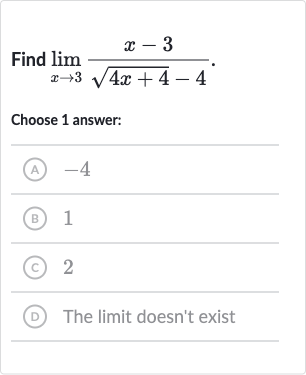Full solution
Q. Find .Choose answer:(A) (B) (C) (D) The limit doesn't exist
- Identify Indeterminate Form: Identify the indeterminate form.We need to evaluate the limit of the function as approaches . Let's first plug in the value of to see if the function is defined at that point or if it results in an indeterminate form.This is an indeterminate form, so we cannot directly evaluate the limit.
- Rationalize Denominator: Rationalize the denominator.To resolve the indeterminate form, we can multiply the numerator and the denominator by the conjugate of the denominator. The conjugate of is .
- Apply Difference of Squares: Apply the difference of squares formula.When we multiply the denominator by its conjugate, we get a difference of squares, which simplifies to:
- Simplify Expression: Simplify the expression.Now we simplify the numerator and the denominator separately:Numerator: Denominator: The limit becomes:
- Factor Out Common Term: Factor out the common term in the denominator.We notice that the denominator can be factored out as . This will allow us to cancel out the term in the numerator and the denominator.
- Cancel Common Terms: Cancel out the common terms.After factoring, we can cancel the term in the numerator and the denominator:
- Plug in Value: Plug in the value of . Now that we have simplified the expression and eliminated the indeterminate form, we can safely substitute into the limit:

